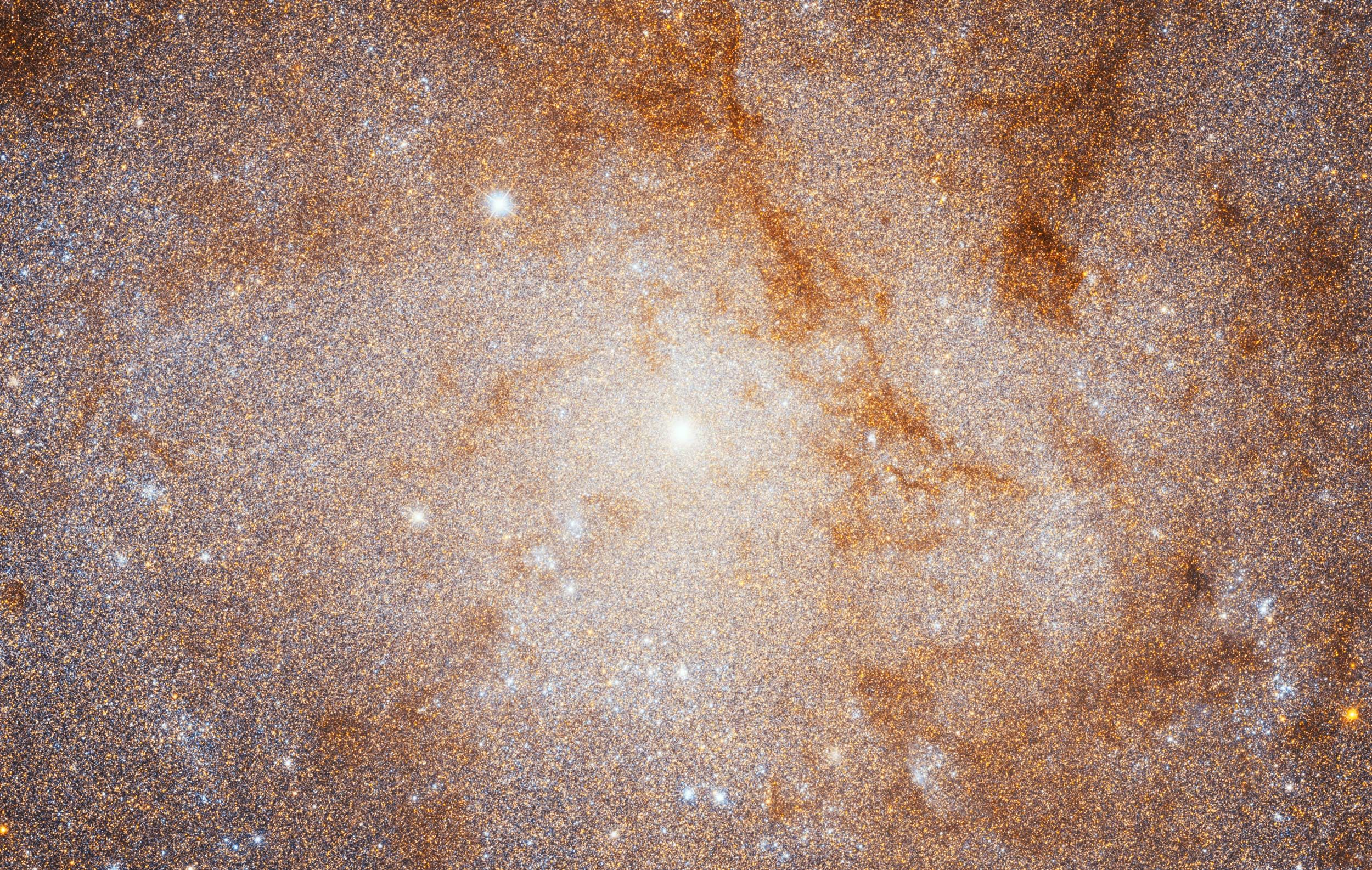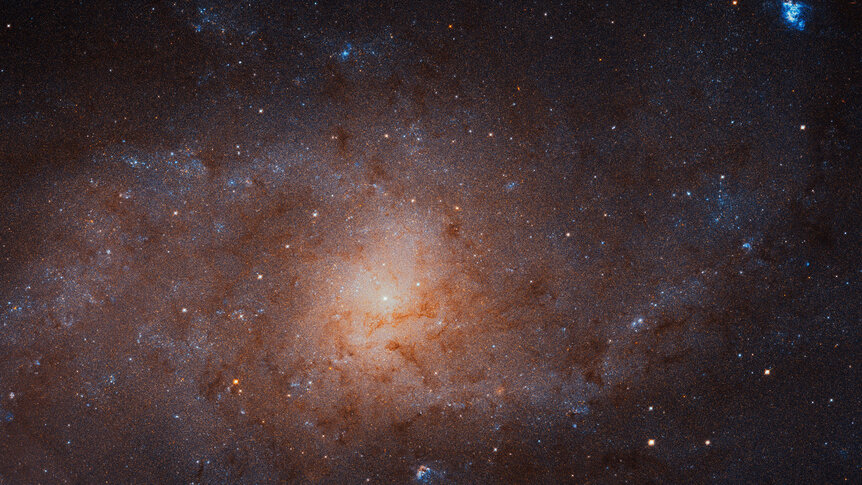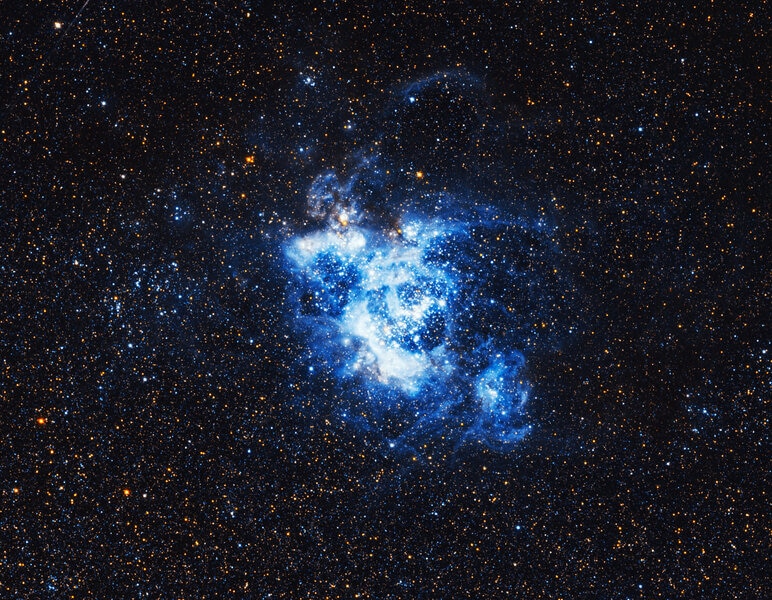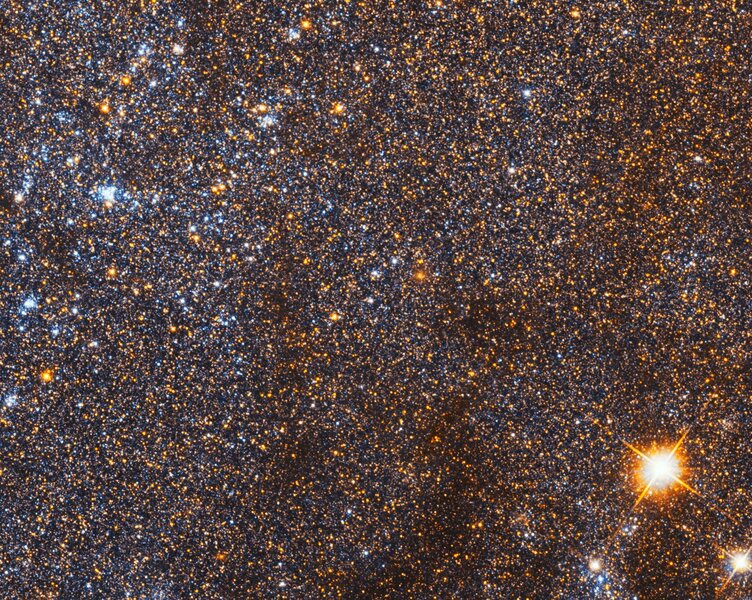Create a free profile to get unlimited access to exclusive videos, sweepstakes, and more!
T R I A N G U L U M

Our Sun is one of a trillion or so stars in the Milky Way galaxy, a flat disk about 100,000 light years across, which in turn is one of a few dozen in the Local Group, a collection of galaxies large and small about 10 million light years across. It’s dominated by two big spirals: us, and the Andromeda galaxy.
There’s a third big-ish spiral, though, one that pretty commonly gets overlooked. Called M33, or sometimes the Triangulum Galaxy, it’s smaller than Andromeda, and also farther away (2.9 million light years versus Andromeda’s 2.5). Even worse, it’s face-on to us, spreading its light out. So, while Andromeda is an easy naked-eye object from dark sites, M33 is right on the edge of visibility, and can be tough even with binoculars from moderately light-polluted skies.
But that makes it no less significant, no less wondrous, and no less jaw-droppingly beautiful. And while you don’t need a Hubble Space Telescope to prove it, well, it doesn’t hurt.
That image is a mosaic of 54 separate Hubble fields (using two filters each, so over 100 separate images!), seamlessly stitched together to show you just the inner part of M33 — the entire galaxy is roughly twice this size.And I know, you’re probably thinking, “Yeah, that’s cool and all, but we’ve seen lots of more beautiful galaxies. What’s so special about this?”
Well, if it doesn’t look all that spectacular to you, maybe that’s because I took the full resolution 32,073 x 41,147 pixel (!!!) image and shrank it down to 2,000 pixels wide to fit the blog. Be glad I did; the original file is 1.64 Gb. Bit of a bandwidth choker.
So, for example, see that little blue blob to the upper right? That’s NGC 604, a star-forming nebula in M33. It looks like not so big a deal here, right?
Yeah, sure. Here it is at full resolution:
Yowza! That’s better. Now you can see it’s an enormous and sprawling gas cloud, birthing massive stars in its center so hot and luminous they are literally carving a hole in the middle of the nebula, blowing out a bubble with their fierce stellar winds and intense ultraviolet radiation.
Oh, by the way: I lied. That’s still not full resolution. I shrank it by about 30% so I could show it aesthetically here.
Incidentally, if you’re wondering why it’s blue and not the usual pinkish-red, that’s because the image here is composed of two colors, using a near-infrared and a blue-green filter. When you warm up hydrogen it emits most of its light at a wavelength of about 656 nanometers, in the red part of the spectrum. We call this H-alpha, and neither filter used here can see that. But hydrogen also emits at H-beta, at 486 nm, and that’s smack dab in the middle of the blue-green filter used here. That’s why the nebula looks so blue (the filter also can see light emitted by low density warm oxygen which is plentiful in nebulae, too; that emits at 501 nm which the filter can also see, so it adds to the brightness of the nebula as well).
Now, looking back at the full-field image of the galaxy, it looks noisy, doesn’t it? Grainy?
Yeah, that’s not grain. It’s stars. Millions and millions and millions of stars. There are an estimated 25 million fully resolved stars in the big image.
That’s a random spot I chose to show you at full res (the two red stars to the lower right are just to the lower left of the galaxy nucleus). If you want to try to count those stars, be my guest. But just in this frame I estimate there are over 100,000 stars (I counted up the stars in a small section and then scaled it up to the full image).
You can also see some regions that appear to have fewer stars. That’s correct! Well, kinda: These are the locations of dust clouds, enormous streamers of tiny silicate and carbon grains. They’re actually incredibly tenuous, but so huge (light years deep) that they become opaque to light, blocking the star behind them. They also tend to scatter away blue light and let redder light pass through, and if you look carefully you’ll see the stars are redder in those locations. So it’s not that there are fewer stars there, it’s that they’re blocked by the dust. Science!
We astronomers (well, me) like to say sometimes that a galaxy is like a city, and the nucleus is the downtown section. That really hits home in this image. Here’s the core of M33:
Holy wow. And that’s not full-res either; I shrank it down by a factor of about 3. But you can see millions of stars, plenty of dust clouds, and a bright, central core. Right at the center of that may be a very large black hole. Interestingly, not much is known about it, even though M33 is one of the two closest big galaxies in the Universe to us! Poking around the scientific literature, strictly speaking it doesn’t seem we can rule out there is no black hole there! That’s weird; every big galaxy should have one. The Milky Way’s is over 4 million times the mass of the Sun, and the one in the center of Andromeda is over 100 million times the Sun’s mass. It looks like, at best, M33’s central black hole is a paltry few thousand times the mass of Sun. I didn’t know that until researching this article, so I learned something!
Interestingly, the central region of M33 looks like it underwent a burst of star formation in the past, about 70 million years ago, which created some hundred million stars or more. That would explain why the core looks so bright.
By the by, this spectacular image wasn’t taken just for kicks. It’s a project by my pal Julianne Dalcanton, who wanted to map M33 in high resolution by Hubble in order to reap quite a bit of scientific treasure. The data tell her the history of star formation in the galaxy, the layout of interstellar gas and dust, the temperatures and luminosities of tens of millions of stars, the mass function of those stars (how many stars of a given mass are born there, where there are few high-mass stars and lots of dinky ones), and information on about a thousand star clusters.
Oh, and about those star clusters: She’s enlisting the aid of citizen scientists — that means you — to help her look for them. Go to ClusterSearch.org and help her out, for science.
Incidentally, a few years back she used Hubble to make the same sort of observation of Andromeda, with even more dramatic results. See for yourself. I remember that when I first saw that shot I wasn’t hugely impressed, until I realized all that noise I saw in the image was actually just stars crammed in shoulder to shoulder. Once that set in, I could feel the cold fingers of awe running down the back of my neck.
Galaxies are big. Incomprehensibly big.
But… they’re not. I mean, yeah, they’re big, but not incomprehensibly so. We can comprehend them, which is exactly why observations like these are made. A little over a century ago we didn’t even know what galaxies were. Now we take their measure using space-based telescopes armed with sophisticated digital detectors, and apply huge amounts of computing and brain power to, well, comprehend them.
This is what science does. It helps us understand. That’s just my most favorite thing ever.






























